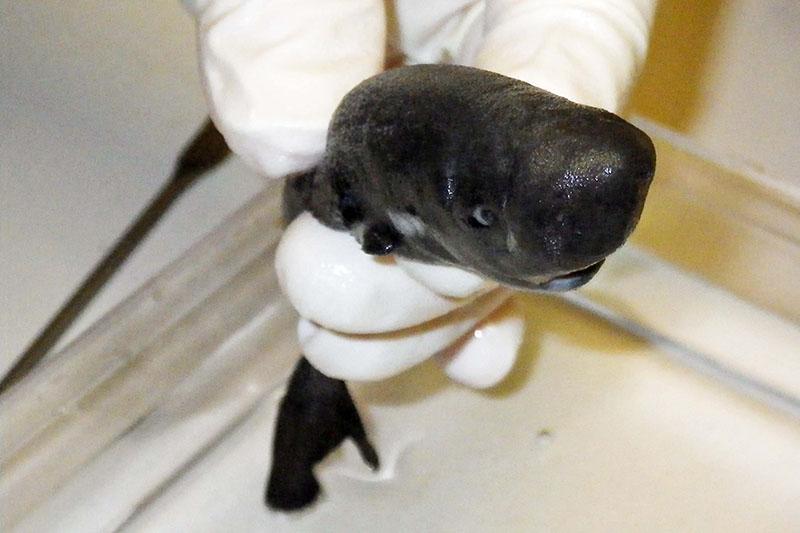Researchers identify new species of pocket shark
A team of researchers, including two from Tulane University, has identified a new species of pocket shark, following careful study of a pocket shark that made international headlines in 2015 after it was brought to the Royal D. Suttkus Fish Collection at the Tulane University Biodiversity Research Institute.
The 5½-inch male kitefin shark has been identified as the American Pocket Shark, or Mollisquama mississippiensis, based on five features not seen in the only other known specimen of this kind. That specimen was captured in the Eastern Pacific Ocean in 1979 and is now housed at the Zoological Museum in St. Petersburg, Russia.
The details of the new species, which was caught in the Gulf of Mexico in February 2010, are described in an article published in the animal taxonomy journal Zootaxa. The authors include Mark Grace of the NMFS Mississippi Laboratories of the National Oceanic and Atmospheric Administration (NOAA) and Henry Bart and Michael Doosey of the Tulane University Biodiversity Research. Other researchers involved in the study are John S. Denton and Gavin Taylor of the Florida Program for Shark Research at the University of Florida, and John Maisey of the Department of Vertebrate Paleontology at the American Museum of Natural History in New York.
“The fact that only one pocket shark has ever been reported from the Gulf of Mexico, and that it is a new species, underscores how little we know about the Gulf."
Henry Bart, director of the Tulane Biodiversity Research Institute
“In the history of fisheries science, only two pocket sharks have ever been captured or reported,” Grace said. “Both are separate species, each from separate oceans. Both are exceedingly rare.”
Bart added, “The fact that only one pocket shark has ever been reported from the Gulf of Mexico, and that it is a new species, underscores how little we know about the Gulf - especially its deeper waters - and how many additional new species from these waters await discovery.”
Researchers said there were notable differences between the original Pacific Ocean specimen and the newer specimen from the Gulf of Mexico. Those differences include fewer vertebrae and numerous light-producing photophores that cover much of the body. The two species both have two small pockets that produce luminous fluid (one on each side near the gills).
The pocket shark was collected in February 2010 in the eastern Gulf of Mexico by the NOAA ship Pisces, during a mission to study sperm whale feeding. Much to his surprise, Grace discovered the shark in 2013 while examining specimens that were collected during the NOAA survey. Grace asked Tulane to archive the specimen in its Fish Collection. Soon after, Grace and Tulane postdoctoral researcher Doosey undertook a study to determine what species it was.
Identifying the shark involved examining and photographing external features of the specimen with a dissecting microscope, studying radiographic (x-ray) images and high resolution CT scans. The most sophisticated images of internal features of the shark were produced at the European Synchrotron Radiation Facility (ESRF) in Grenoble, France, which uses the most intense source of synchrotron-generated light in the world to produce x-rays 100 billion times brighter than the x-rays used in hospitals.
Bart said the partnership between Tulane and NOAA was instrumental to the work that lead to the discovery and identification of the American Pocket Shark. “The Tulane-NOAA Fisheries partnership is continuing and may lead to additional discoveries in the future,” he said.

